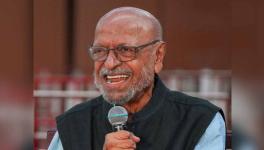The Brief Life of Propaganda Films
Representational use only.Image Courtesy: Max Pixel
From Mary Kom to Mithali Raj, ‘Silk’ Smitha to Sanjay Dutt and Sarabjit Singh to Sardar Udham, Bollywood’s strong appetite for biopics has never showed signs of waning. An upcoming one, Randeep Hooda’s directorial debut in which he plays the character of Swatantrya Veer Savarkar, has landed in controversy since the release of the teaser. Many have termed it a brazen attempt to twist history by portraying Hindutva icon VD Savarkar as the inspiration for legendary freedom fighters Khudiram Bose, Subhas Chandra Bose and Bhagat Singh. First impressions indicate the movie belongs to the genre of propaganda films rather than biopic and will likely join the ranks of the Vivek Oberoi starring film, PM Narendra Modi.
Given the present regime’s fondness for monolithic narratives, more films will likely join the bandwagon, such as India House, bankrolled by Ram Charan, also believed to be based on Savarkar. The content of a movie dwells in the creative domain of its writer and the filmmaker, which those in power are not to interfere with lightly. But what if the contours of creativity are designed by the powerful?
History and present experiences show us that while Fascist regimes repressed films, they also deployed them as tools to sustain their brutal power.
Mob Psychology and Fascist Cinema
The classic example of cinema used as propaganda is from Nazi Germany. Hitler and his chief propagandist Joseph Goebbels were ardent movie buffs. They privately relished American-British movies but detested them publicly, emphasising a need for “pure” German films. Before the rise of Nazism, Germany had a rich legacy of filmmaking and abundant talents in the industry, from writers and actors to technicians and directors.
Things went from bad to worse in 1933 in Hitler’s regime when he brought the cinema industry under the Reich Ministry for People’s Enlightenment and Propaganda, which Goebbels headed. Goebbels constantly interfered with screenplays, and soon he was deciding who should write, direct and act in the movies. Jews were expelled from the industry, and in 1937, Hitler nationalised the film industry. Film criticism had been banned by then.
The Nazi control over the cinematic content was absolute. The goal was not just to create zombie-minded masses who admired ultranationalism, war-mongering and genocides but to divert public attention from the regime’s inability to alleviate real-life miseries. To make mindsets compatible with the Nazi worldview, a string of commercial movies was made other than direct propaganda. For example, Ich Klage or I Accuse was a pro-euthanasia propaganda film Goebbels commissioned to manufacture public support for Aktion T4, a project to involuntarily euthanise people and conduct experiments on coerced concentration camp prisoners.
Goebbels wanted to make war films like Mrs Miniver, a Hollywood drama production from 1943 that tells the story of a fictional middle-class British family during the Second World War. One of the unwritten rules in Nazi Germany was that whenever Hitler was shown in a film or documentary, the camera should be placed at a lower angle to make him appear larger than life. The documentary, Triumph of the Will, is an archetype of this propaganda filmmaking style.
Hitler wanted a German version of the Hollywood film Viva Villa, which dramatised the life of Mexican revolutionary Francisco “Pancho” Villa—only he would replace Pancho in the film. But Goebbels sensed danger, thinking Viva Villa was too revolutionary and likely to leave an undesired impression on the audiences. (Meanwhile, in Italian cinema, a popular recurring character, Maciste, a good-hearted strongman-giant, became increasingly reminiscent of Benito Mussolini.)
During the Second World War, Goebbels ordered more propaganda movies, which he considered essential weapons to sustain the conflict. Even when Berlin was under fire, the regime bombarded German theatres with films that lacked quality and humanity. Only after the war could humanity, feelings, music and creativity return to cinema.
Hindutva Propaganda Movies
Now and then, since 2015, the Hindi film industry has released propaganda movies, especially in the garb of historical drama. There is ample room for creative liberty even in films drawing their stories from historical events. For example, the Quentin Tarantino film Inglorious Basterds depicts Hitler gunned down in a theatre, which is not how historians understand he died.
But in the Sanjay Leela Bhansali movie, Bajirao Mastani, the Maratha Peshwa’s war cry is, “Hindu Swaraj—the only dream of Chhatrapati Shivaji”, when we know Shivaji’s administration and regime did not pursue communitarian goals and that his chief motivation was to expand the geographical limits of his empire. The film, Tanhaji: The Unsung Hero, depicts an Om symbol in the centre of a saffron flag of the Maratha empire. Both films use the creative license to create narratives with profound implications for India. Tanaji Malusare and his wife, Savitri Malusare, belonged to a fisherfolk community, the Kolis, while the movie depicts them in a Brahmanical way. Savitri’s character even says in the film that when Shivaji draws his sword, it ‘protects the dignity of women and the holy thread of the Brahmin’. This trend has some instances outside Bollywood and the Hindi film industry, such as RRR, in which a revolutionary [Alluri Sitarama Raju, who used guerrilla tactics, including a hermit’s disguise, to fight the British empire], is incredibly presented as the Hindu god Lord Rama, with Jai Shri Ram chants echoing in the background score!
Buried Motion Pictures of Afghanistan
Fascists in Europe and their Indian counterparts strangle films that don’t march in tune with their narratives and degrade cinema into a propaganda tool. But in Afghanistan, even a movie that celebrates the ruling Taliban regime will lead to a beheading, as film, music, literature, art and most other good things on Earth are branded as “anti-Islam” and banned. Afghanistan had a vibrant film culture before Taliban rule. When it first came to power in the 1990s, over 7,000 Afghan films were buried under the soil in cylinders, concealed in false ceilings or built into brick walls.
Habibullah Ali and his colleagues at State-run Afghan Film tirelessly preserved hours of motion pictures which revived the industry when the Taliban rule ended in 2001. Film festivals resumed then, and women filmmakers were recognised worldwide for their creations. The much-celebrated Osama (2003) and Wajma, an Afghan Love Story (2013), were made during the ensuing twenty years. With the Taliban back in power, noted filmmakers had to flee Afghanistan—the only difference now is that they did not have to bury film reels in canisters as they can be preserved digitally.
South Korean Cinema: Lesson for India
When creative freedom is stifled, it destroys art, industry, and the public sphere. On the other hand, there are instances of cinema free of shackles reaching its zenith. The global acceptance of South Korean cinema with its K-Dramas and K-Pop is a phenomenon to be reckoned with. The journey was difficult, for Koreans had abandoned their cinema for Hollywood. From the days of the Japanese occupation, stringent censorship choked Korean cinema, and subsequent regimes continued this authoritarian trend. But when censorship laws were relaxed in the 1990s, Korean cinema flourished after the Korean people relentlessly fought democratic struggles.
The personal and political experiences of Koreans translated into the language of cinema, and the emerging filmmakers were often part of these struggles. It supported the robust scenario that the government did not interfere with the creative space and strengthened film festivals after the first successful Busan International Film Festival in 1996. The festivals celebrated all forms of cinema and diversity, and they resulted from grassroots movements against tyranny! The lesson for India is that free cinemas will rise and shine, breaking the fetters of dictators and their propagandists. It happened in Korea, and it will happen all over the world.
The author is a lawyer practising in the High Court of Kerala. The views are personal.
Get the latest reports & analysis with people's perspective on Protests, movements & deep analytical videos, discussions of the current affairs in your Telegram app. Subscribe to NewsClick's Telegram channel & get Real-Time updates on stories, as they get published on our website.
























